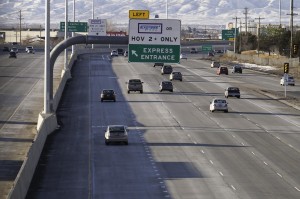A number of bills have been proposed in attempt to tackle Utah’s dire pollution problem, but some lawmakers argue the only bill passed thus far could be a step in the wrong direction when it comes to cleaning up Utah’s air.

Currently, clean-air vehicles are permitted in Utah’s High Occupancy Vehicle lanes with the one-time purchase of a $10 “C decal.” HB23, passed with bipartisan support, will set a cap on the number of these “green” vehicles permitted in HOV lanes, limiting the count to 6,000 in attempt to reduce traffic and preserve the official intent of the lanes, which is an incentive to carpool.
Organizations like the Alliance for a Better Utah feel strongly the bill will have a negative effect on Utah’s already dismal air quality by removing motivation for Utah citizens to purchase “green” cars.
A statement released by the Alliance for a Better Utah reads, “Clean air remains a priority among Utahns. Our state legislators need to consider the collateral damage that even simple bills like HB23 have on our ability to breathe clean air. State legislators should be encouraging the use of clean air technology, not penalizing it.”
Utah drivers of hybrid cars, like Genene Cluff of Midway, agree.
“Obviously a hybrid is more money, and I really think that if people are willing to pay a little more for their vehicle to help out our environment they should be rewarded in some way,” Cluff said. “The HOV lane is definitely a reward, and if they limit or take that away, then that really diminishes the incentive therein.”
Maryann Martindale, executive director of the Alliance for a Better Utah, said she has yet to see a bill that has been proposed in a proactive attempt to fix Utah’s pollution problem. Instead, HB23 and SB 191, which raises speed limits on major highways, have been brought to the table, both of which could worsen air quality. Martindale called these bills “counterproductive to the need to try to do something for clean air.”
Martindale said she did not have reason to believe that Utah legislators had even considered the air damage HB23 could bring with it.
“I don’t think they even reviewed the air quality component to this,” she said.
The bill’s sponsor, Rep. Stephen Handy, R-Layton, said the Utah Department of Transportation asked him to promote the bill in an effort to prevent overcrowding in HOV lanes, which were originally designed to accommodate carpooling. He explained that contributing to Utah’s pollution was in no way the intention of the bill.
“The bill has nothing to do with the state not wanting to promote the driving of clean-fuel vehicles. We want as many of those as we can,” Hardy said.
Hardy explained that while UDOT already monitors the number of regular vehicles with purchased passes for the HOV lane by adjusting transponder prices, it has no control over how many clean-air vehicles occupy the lanes. This bill, according to Hardy, is an attempt to develop a similar measure of “green” vehicles. Currently, there are 4,600 registered clean-air vehicles using Utah’s HOV lanes, with about 80 more coming in each month. The 6,000 cap, when reached, would provide an opportunity for UDOT to reevaluate whether “green” vehicles should be permitted in the lanes at all.
“They’re trying to balance it back and forth to achieve the integrity of the lanes for which they were built, which is carpooling,” Hardy said.
But instead of limiting the clean-air vehicles, Martindale said the number of purchased HOV passes should be limited by legislators.
“They’re turning their backs on cars that are actually helping the environment and giving them this perk of driving in this lane in favor of all of these single-driving cars, which very many of them could easily be SUVs just because they purchased a permit to drive,” she said. “We think that’s the wrong approach to it.”




